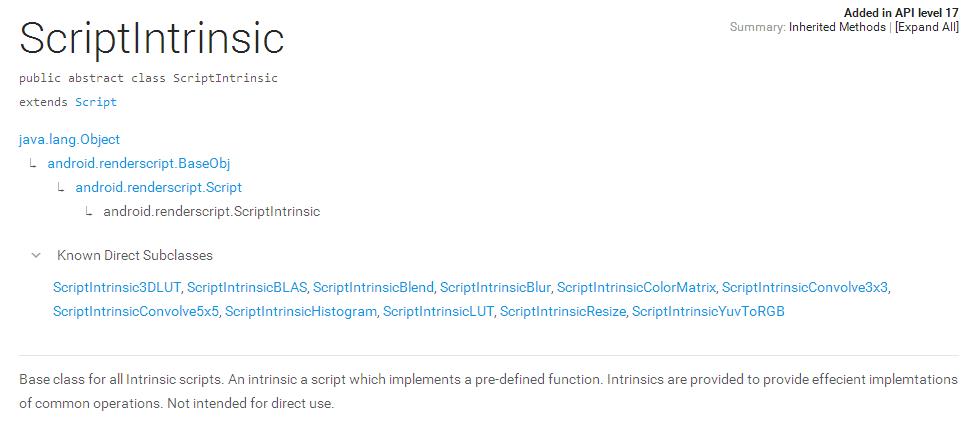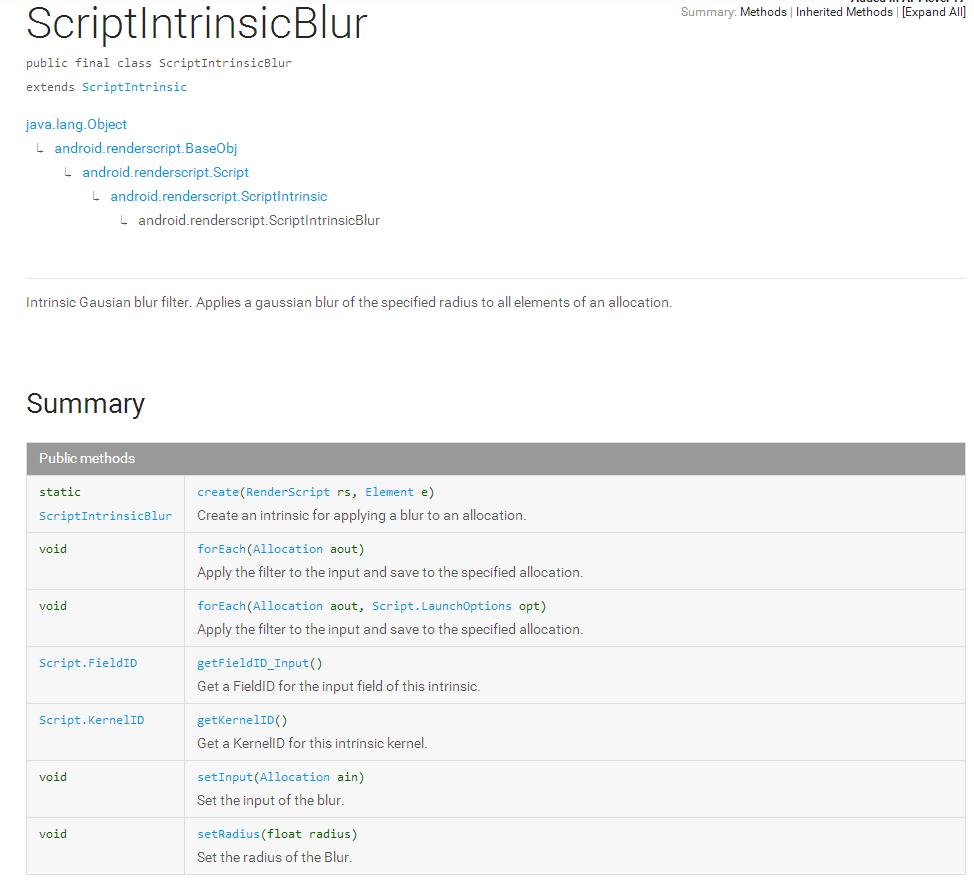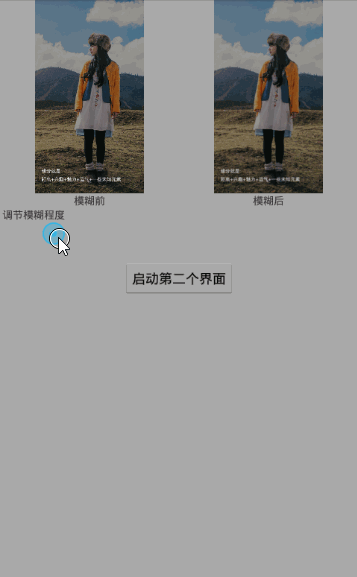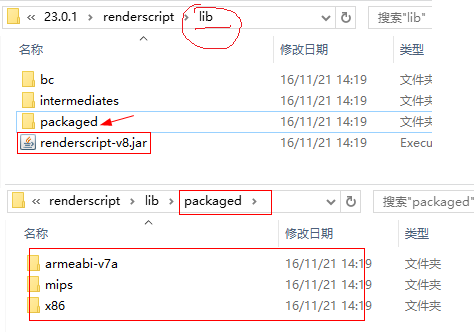昨天看了下RenderScript的官方文档,发现RenderScript这厮有点牛逼。无意中发现ScriptIntrinsic这个抽象类,有些很有用的子类。其中有个子类叫ScriptIntrinsicBlur类,大致就是将图片实现高斯模糊。
ScriptIntrinsic的申明:
ScriptIntrinsicBlur类的申明:
加上结合着看了下SDK中的samples,自己写了个高斯模糊。
( sample的具体位置为:
SDK目录/samples/android-19/renderscript/RenderScriptIntrinsic/RenderScriptIntrinsicSample/
)。
先上图。效果如下:
【注意!! 开始之前,我们需要导入需要的支持包。
支持包的具体路径为:
sdk目录/buildtools/任意一个版本号/renderscript/lib/renderscript-v8.jar
另外:为了防止出现有的机型兼容问题,最好将renderscript-v8.jar同目录下的packaged目录下的所有库也一并拷贝到lib文件夹下】
例如:
好了。开始写代码。。
1、先申明常用成员变量。
private SeekBar blurSeekBar;//拖动条
private ImageView img_blur;//显示模糊后bitmap的ImageView
//原bitmap和高斯模糊后的bitmap
private Bitmap bitmap_original, bitmap_blur;
//高斯模糊处理的AsyncTask
private RenderScriptTask mLatestTask = null;
//RenderScript 对象(Google的高性能并行计算类,他可以利用设备的GPU/CPU等计算资源)
private RenderScript mRS;
//下面是两个RenderScript的传入参数对象
private Allocation mInAllocation;
private Allocation mOutAllocation;
//高斯模糊处理实例
private ScriptIntrinsicBlur mScriptBlur;2、加载两份bitmap,并初始化高斯模糊相关的对象。
@Override
protected void onCreate(Bundle savedInstanceState) {
super.onCreate(savedInstanceState);
setContentView(R.layout.activity_main);
blurSeekBar = (SeekBar) findViewById(R.id.aty_main_seekBar);
img_blur = (ImageView) findViewById(R.id.aty_main_img_blur);
bitmap_original = loadBitmap(R.drawable.meet_entry_guide_3);
// 复制一份
bitmap_blur = Bitmap.createBitmap(bitmap_original.getWidth(),
bitmap_original.getHeight(), bitmap_original.getConfig());
createBlureScript();
setSeekBarListening();//为SeekBar设置拖拽监听
}
/**
* Helper to load Bitmap from resource
*/
private Bitmap loadBitmap(int resource) {
final BitmapFactory.Options options = new BitmapFactory.Options();
options.inPreferredConfig = Bitmap.Config.ARGB_8888;
return BitmapFactory.decodeResource(getResources(), resource, options);
}
/**
* 创建Script
*/
private void createBlureScript() {
mRS = RenderScript.create(this);
mInAllocation = Allocation.createFromBitmap(mRS, bitmap_original);
mOutAllocation = Allocation.createFromBitmap(mRS, bitmap_blur);
/*
* Create intrinsics. RenderScript has built-in features such as blur,
* convolve filter etc. These intrinsics are handy for specific
* operations without writing RenderScript kernel. In the sample, it's
* creating blur, convolve and matrix intrinsics.
*/
mScriptBlur = ScriptIntrinsicBlur.create(mRS, Element.U8_4(mRS));
}3、完成高斯模糊处理代码。
private void performFilter(Allocation inAllocation,
Allocation outAllocation, Bitmap bitmapOut, float value) {
/*
* 设置模糊程度。范围在0~25之间。否则会出错
*/
mScriptBlur.setRadius(value);
/*
* Invoke filter kernel
*/
mScriptBlur.setInput(inAllocation);
mScriptBlur.forEach(outAllocation);
outAllocation.copyTo(bitmapOut);
}4、将处理后的bitmap设置到ImageView中。
// Request UI update
img_blur.setImageBitmap(bitmap_blur);
img_blur.invalidate();基本工作也就完成了。剩下就是代码的相互调用了。
【 总 结 】
其实总起来,使用RenderScript进行高斯模糊主要是分为三步:
1、创建并初始化需要的对象(初始化一次就OK)。
mRS = RenderScript.create(this);
mScriptBlur = ScriptIntrinsicBlur.create(mRS, Element.U8_4(mRS));
//RenderScript的输入和输出参数对象
mInAllocation = Allocation.createFromBitmap(mRS, bitmap_original);
mOutAllocation = Allocation.createFromBitmap(mRS, bitmap_blur);2、执行高斯模糊,并将结果拷贝出来。
/*
* 设置模糊程度。范围在0~25之间。否则会出错(这个也可以只设置一次)
*/
mScriptBlur.setRadius(value);
/*
* Invoke filter kernel
*/
mScriptBlur.setInput(inAllocation);
mScriptBlur.forEach(outAllocation);
//将结果拷贝出来,拷贝到bitmapOut对象中
outAllocation.copyTo(bitmapOut);3、回收RenderScript对象
mRS.destory();
mRs = null; 文章到此结束。
按照惯例:下面是我的完整的代码实现。
public class MainActivity extends Activity {
private SeekBar blurSeekBar;
private ImageView img_blur;
private Bitmap bitmap_original, bitmap_blur;
private RenderScriptTask mLatestTask = null;
private RenderScript mRS;
private Allocation mInAllocation;
private Allocation mOutAllocation;
private ScriptIntrinsicBlur mScriptBlur;
@Override
protected void onCreate(Bundle savedInstanceState) {
super.onCreate(savedInstanceState);
setContentView(R.layout.activity_main);
blurSeekBar = (SeekBar) findViewById(R.id.aty_main_seekBar);
img_blur = (ImageView) findViewById(R.id.aty_main_img_blur);
bitmap_original = loadBitmap(R.drawable.meet_entry_guide_3);
// 复制一份
bitmap_blur = Bitmap.createBitmap(bitmap_original.getWidth(),
bitmap_original.getHeight(), bitmap_original.getConfig());
createBlureScript();
setSeekBarListening();
}
/**
* 设置SeekBar的监听
*/
private void setSeekBarListening() {
blurSeekBar.setOnSeekBarChangeListener(new OnSeekBarChangeListener() {
@Override
public void onStopTrackingTouch(SeekBar seekBar) {
}
@Override
public void onStartTrackingTouch(SeekBar seekBar) {
}
@Override
public void onProgressChanged(SeekBar seekBar, int progress,
boolean fromUser) {
updateImage(progress);
}
});
}
/**
* 创建Script
*/
private void createBlureScript() {
mRS = RenderScript.create(this);
mInAllocation = Allocation.createFromBitmap(mRS, bitmap_original);
mOutAllocation = Allocation.createFromBitmap(mRS, bitmap_blur);
/*
* Create intrinsics. RenderScript has built-in features such as blur,
* convolve filter etc. These intrinsics are handy for specific
* operations without writing RenderScript kernel. In the sample, it's
* creating blur, convolve and matrix intrinsics.
*/
mScriptBlur = ScriptIntrinsicBlur.create(mRS, Element.U8_4(mRS));
}
private void performFilter(Allocation inAllocation,
Allocation outAllocation, Bitmap bitmapOut, float value) {
/*
* Set blur kernel size
*/
mScriptBlur.setRadius(value);
/*
* Invoke filter kernel
*/
mScriptBlur.setInput(inAllocation);
mScriptBlur.forEach(outAllocation);
outAllocation.copyTo(bitmapOut);
}
/*
* In the AsyncTask, it invokes RenderScript intrinsics to do a filtering.
* After the filtering is done, an operation blocks at Allication.copyTo()
* in AsyncTask thread. Once all operation is finished at onPostExecute() in
* UI thread, it can invalidate and update ImageView UI.
*/
private class RenderScriptTask extends AsyncTask<Float, Integer, Integer> {
Boolean issued = false;
protected Integer doInBackground(Float... values) {
if (isCancelled() == false) {
issued = true;
performFilter(mInAllocation, mOutAllocation, bitmap_blur,
values[0]);
}
return 0;
}
void updateView(Integer result) {
// Request UI update
img_blur.setImageBitmap(bitmap_blur);
img_blur.invalidate();
}
protected void onPostExecute(Integer result) {
updateView(result);
}
protected void onCancelled(Integer result) {
if (issued) {
updateView(result);
}
}
}
/*
* Invoke AsynchTask and cancel previous task. When AsyncTasks are piled up
* (typically in slow device with heavy kernel), Only the latest (and
* already started) task invokes RenderScript operation.
*/
private void updateImage(int progress) {
float f = getBlureParam(progress);
if (mLatestTask != null)
mLatestTask.cancel(false);
mLatestTask = new RenderScriptTask();
mLatestTask.execute(f);
}
/**
* 模糊的值在1 ~ 25之间
*
* @param progress
* SeekBar的进度值(0 ~ 100)
* @return 模糊值
*/
private float getBlureParam(int progress) {
final float max = 25.0f;
final float min = 1.f;
return (float) ((max - min) * (progress / 100.0) + min);
}
/**
* Helper to load Bitmap from resource
*/
private Bitmap loadBitmap(int resource) {
final BitmapFactory.Options options = new BitmapFactory.Options();
options.inPreferredConfig = Bitmap.Config.ARGB_8888;
return BitmapFactory.decodeResource(getResources(), resource, options);
}
}

























 1256
1256











 被折叠的 条评论
为什么被折叠?
被折叠的 条评论
为什么被折叠?








